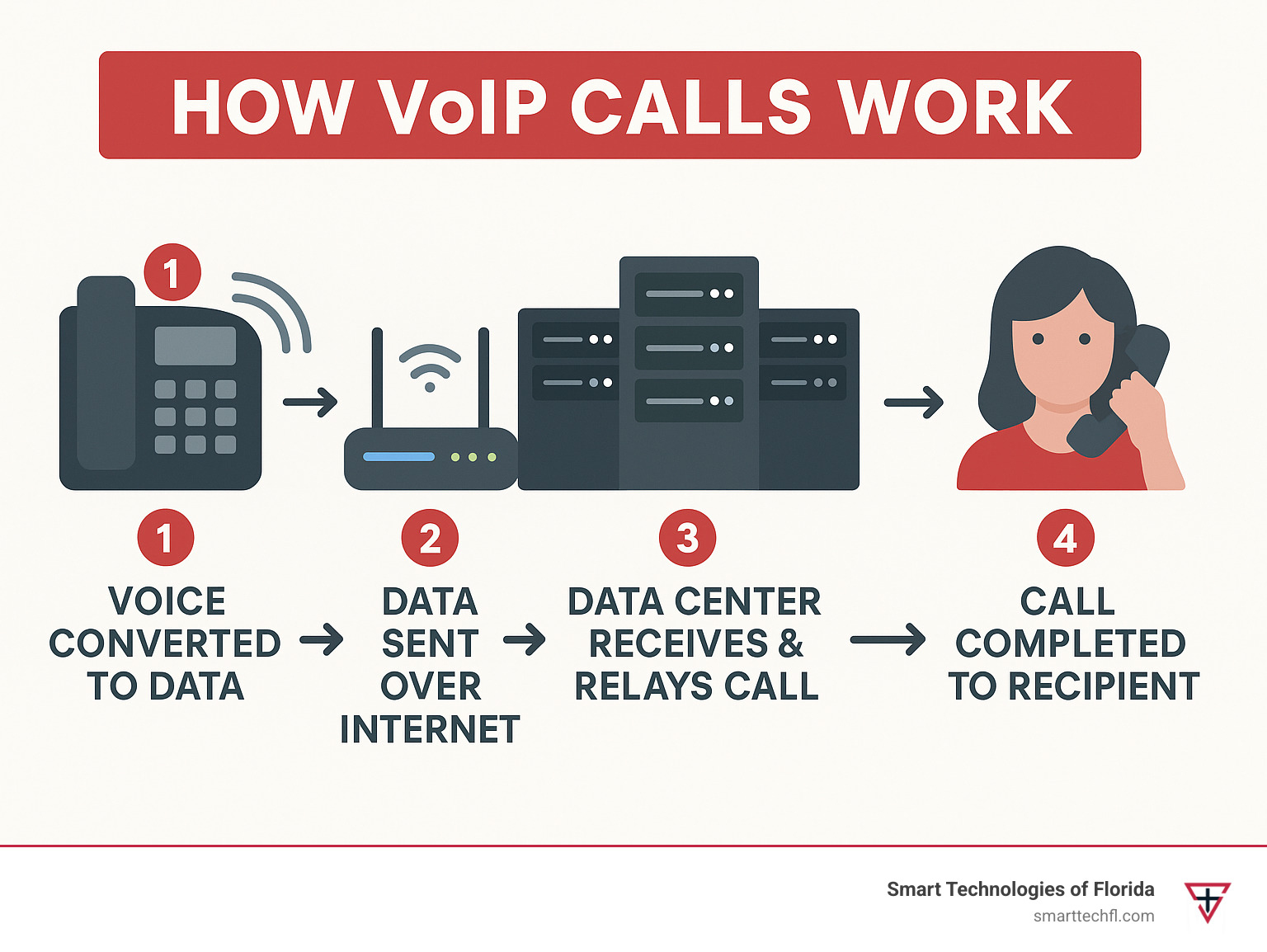Voice Over IP: The Best Business Providers for 2025
Business voice over ip providers are revolutionizing how companies communicate, and it’s not just about keeping up with technology trends. The shift to VoIP represents a fundamental change in how businesses operate, save money, and stay competitive.
Top Business VoIP Provider Types for 2025:
- All-in-One Unified Communications – Voice, video, messaging, and collaboration in one platform
- Core Calling Solutions – High-quality voice with essential features for small businesses
- Customizable API Platforms – Developer-focused solutions with programmable features
- Enterprise-Grade Systems – Scalable solutions for large organizations with complex needs
The numbers tell the story. VoIP systems typically beat analog telephony costs by 30-70%, according to industry data. Meanwhile, household landline use continues to fall, with just over 40% of homes currently having landlines – and businesses are following the same trend.
But cost savings are just the beginning. VoIP transforms how your team works by enabling:
- Remote work flexibility through softphone apps
- Professional image with auto-attendants and call routing
- Easy scalability – add users without new hardware
- Advanced features like voicemail transcription and CRM integration
As one business owner shared in recent discussions: “I’m saving more than 50% and getting amazing sound quality.” Another noted: “We can easily add users without worrying about expensive switch upgrades.”
The transition isn’t without challenges. VoIP depends on internet connectivity, requires some staff training, and needs proper setup for optimal call quality. However, these problems are easily overcome with the right provider and preparation.

Why Your Business Needs to Switch to a VoIP Phone System
Think about it this way: if your business is still using a traditional landline system, you’re essentially driving a horse and buggy while everyone else is cruising in electric cars. It’ll get you from point A to point B, but you’re missing out on incredible efficiency, substantial savings, and the kind of flexibility that modern business voice over ip providers deliver every single day.

This isn’t just about getting the latest gadget for your office. We’re talking about a complete change of how your business communicates – one that future-proofs your operations and gives you a real competitive advantage. It’s about making strategic decisions that will benefit your business for years to come.
When you’re ready to explore how VoIP can revolutionize your operations, our team at Smart Technologies of Florida has comprehensive insights on Business Communication Solutions: VoIP that can help guide your decision.
VoIP vs. Traditional Landlines: A Clear Winner
Let’s be honest – traditional landlines are like that old filing cabinet in your office that everyone works around but nobody wants to deal with. They’re expensive, inflexible, and frankly, they’re holding your business back. When we put VoIP systems head-to-head with these outdated setups, there’s really no contest.
The cost difference alone is staggering. Remember those 30-70% savings we mentioned earlier? That’s not just marketing fluff – it’s real money back in your pocket. Traditional systems hit you with high upfront hardware costs, expensive installation fees, and those per-minute charges that seem to multiply like rabbits. VoIP leverages your existing internet connection, which means you’re not paying for separate phone lines that cost a fortune.
Hardware and maintenance headaches become a thing of the past. Those bulky on-premise Private Branch Exchange (PBX) systems were nightmares – they needed dedicated IT staff, constant maintenance, and expensive hardware upgrades that always seemed to happen at the worst possible time. With Cloud PBX, all that equipment lives in your provider’s data center, not cluttering up your office. Updates happen automatically, maintenance is handled remotely, and you can focus on running your business instead of managing phone equipment.
Scalability becomes effortless. Traditional systems made adding a new phone line feel like performing surgery. You’d call a technician, wait for installation, and sometimes even run new wiring through your walls. With VoIP, adding a new employee to your phone system is literally a few clicks in an online portal. Need to remove someone? Just as easy. It takes minutes, not days or weeks.
The trend is unmistakable. According to U.S. phone use statistics, landline use continues to plummet, with just over 40% of homes still having them. Businesses are following the same pattern, rapidly moving away from this outdated technology. The choice between on-premise PBX and Cloud PBX is becoming a no-brainer for most companies.
Key Advantages for Small and Growing Businesses
Beyond the obvious cost savings, VoIP offers advantages that are particularly game-changing for small and growing businesses. These benefits go far beyond just making phone calls cheaper.
Mobility and remote work support have become absolutely crucial in today’s business environment. Your team can make and receive calls from anywhere with an internet connection using softphone apps on their computers or mobile devices. This means your business number follows your employees whether they’re working from home, a coffee shop, or traveling across the country. In our experience, this flexibility has become a major factor in attracting and retaining good employees.
Scalability becomes your secret weapon as your business grows. Traditional phone systems made expansion feel like a major construction project. With VoIP, adding or removing users, lines, and features doesn’t require physical wiring or expensive hardware changes. One of our clients put it perfectly: “We can easily add users without worrying about expensive switch upgrades.” This agility is crucial whether you’re rapidly expanding or dealing with seasonal staffing changes.
Professional image improvement is something every small business owner dreams about. Even if you’re a startup working from a shared office space, VoIP can make you sound like a Fortune 500 company. Auto-attendant features act as virtual receptionists, greeting callers professionally and routing them to the right person or department. Custom call routing ensures no call goes unanswered, creating a seamless experience that impresses clients and builds trust.
Improved productivity comes from features that go way beyond basic calling. Voicemail-to-email transcription means you can read your messages instead of listening to them, potentially saving hundreds of hours per year. Call analytics provide insights into call volumes, peak times, and customer interaction patterns, helping you optimize your operations and make data-driven decisions.
To dive deeper into how these features can boost your business efficiency, explore our comprehensive guide on Top VoIP Features for Small Businesses.
Potential Challenges and How to Overcome Them
We believe in being completely transparent about VoIP implementation. While the benefits are substantial, there are some challenges you should be aware of – and more importantly, how to address them effectively.
Internet dependency is the most significant consideration. Since VoIP relies entirely on your internet connection, if your internet goes down, so does your phone system. The solution is investing in a reliable, high-speed internet connection with sufficient bandwidth for your needs. Consider a backup internet line or mobile hotspots for critical personnel to ensure business continuity.
Call quality issues can occur if your internet connection has problems with bandwidth, latency, or jitter. Poor connectivity can lead to choppy calls, echoes, or dropped connections that frustrate both your team and your customers. The solution involves ensuring your internet service meets your provider’s recommendations and implementing Quality of Service (QoS) settings on your network to prioritize voice traffic over other internet activities.
Power outages affect VoIP phones just like they affect your internet modem and router – no electricity means no phone service. An Uninterruptible Power Supply (UPS) for your critical network equipment and IP phones solves this problem. Many VoIP systems also offer mobile apps that can route calls to cell phones during outages, ensuring you stay connected even when the lights go out.
Security concerns are valid since VoIP runs over the internet and can be vulnerable to threats if not properly managed. The solution is choosing a reputable provider with robust security protocols and compliance certifications. Implement strong passwords, secure network configurations, and regular software updates to protect your communications.
Learning curve challenges might arise as your team adapts to new features and interfaces. While VoIP systems are generally user-friendly, some advanced features might require training. The solution is selecting a provider with an intuitive online portal and comprehensive training resources, plus ensuring thorough onboarding and ongoing support to help your team adapt quickly and confidently.
How to Choose the Right Business Voice Over IP Provider
Choosing the right business voice over ip providers can feel overwhelming at first, but it doesn’t have to be. Think of it like buying a car – you wouldn’t just look at the sticker price, right? You’d consider reliability, features, long-term costs, and how well it fits your lifestyle. The same approach works perfectly for selecting a VoIP provider.

The key is understanding that this isn’t just about picking the cheapest option. You’re making a strategic investment that will impact how your team communicates, how customers perceive your business, and ultimately, your bottom line. It’s about finding the sweet spot between features, reliability, and cost that perfectly aligns with your business goals.
Before diving into specific providers, take a step back and analyze your business needs. How many employees need phone access? Do you have remote workers? What’s your call volume like? Do you need advanced features like call recording or CRM integration? Understanding these fundamentals will guide your decision-making process.
For a broader perspective on selecting the best communication tools, see our insights on Best Business Phone Systems: Top 5 Choices.
Essential Features to Look for in a VoIP Provider
When evaluating business voice over ip providers, think about features as your business communication toolkit. Some are absolutely essential, while others are nice-to-have bonuses that can really lift your operations.
The foundation starts with auto-attendant functionality – essentially a virtual receptionist that greets callers professionally and routes them to the right person or department. This single feature can make a three-person startup sound like a Fortune 500 company. No more worrying about missed calls or unprofessional greetings.
Voicemail-to-email transcription is another game-changer that many businesses don’t realize they need until they have it. Instead of calling into a voicemail system and listening to messages one by one, you receive transcribed voicemails directly in your email inbox. Some providers even claim this feature can save up to 300 hours per year – that’s nearly two full work weeks!
For businesses that need to maintain quality standards or handle sensitive conversations, call recording capabilities are crucial. Whether you’re training new staff, resolving disputes, or ensuring compliance, having the ability to record calls automatically or on-demand provides peace of mind.
Modern businesses thrive on integration, which is why CRM connectivity has become so important. When your phone system talks to your customer relationship management software, magic happens. Customer records pop up automatically when they call, call logs are saved automatically, and your sales team can work more efficiently.
The rise of remote work has made video conferencing and mobile apps essential rather than optional. Your team needs to stay connected whether they’re in the office, at home, or traveling. Quality softphone apps turn any smartphone or computer into a business phone, maintaining professional communication from anywhere.
Don’t overlook business texting capabilities either. More customers prefer text communication for quick updates, appointment confirmations, and customer service interactions. Having SMS and MMS functionality tied to your business number keeps everything centralized.
Finally, call analytics and reporting provide valuable insights into your communication patterns. Understanding peak call times, call duration, and customer interaction patterns helps you optimize staffing and improve customer service.
These features work together to create a comprehensive communication platform that grows with your business. Dive deeper into specific capabilities with our article on Business Phones VoIP: Best Features.
Understanding Reliability, Call Quality, and Uptime
When your phones are your business lifeline, reliability isn’t negotiable. Imagine losing phone service during your busiest sales period or when handling a customer emergency. That’s why understanding uptime guarantees and call quality factors is crucial.
The gold standard in the industry is 99.999% uptime reliability. This might sound like marketing fluff, but it translates to less than six minutes of downtime per year. Reputable providers achieve this through sophisticated network infrastructure, multiple geographically dispersed data centers, and redundant systems that automatically switch if one component fails.
Think of it like having multiple backup generators – if one fails, another kicks in seamlessly. This “bulletproof, disaster-proof service” approach means your calls stay connected even during natural disasters or technical failures.
However, even the best provider can’t overcome poor internet connectivity on your end. VoIP converts your voice into data packets that travel over the internet, so your connection quality directly impacts call quality. Bandwidth determines how many simultaneous calls you can handle without degradation – think of it as the width of your digital highway.
Latency is the delay in data transmission, and high latency creates those awkward conversations where people talk over each other. Jitter refers to variations in latency, which causes choppy audio and dropped words. These technical factors might sound intimidating, but they’re easily managed with proper internet service and network configuration.
Many providers now offer HD Voice technology, which expands the frequency range of audio signals for crystal-clear sound quality. It’s like the difference between listening to AM radio and a high-quality stereo system.
The solution is ensuring your internet connection is stable and fast enough to support your expected call volume. Most providers offer bandwidth calculators and network assessment tools to help you determine your needs.
Understanding these technical aspects helps you appreciate why investing in quality internet service is just as important as choosing the right VoIP provider. Learn more about the underlying technology in our discussion on Cloud Voice Services: Cost Benefits Explained.
Evaluating Cost Savings and Pricing Models
One of VoIP’s biggest attractions is significant cost savings, but understanding pricing models and potential hidden costs is crucial for making an informed decision. It’s like shopping for a cell phone plan – the advertised price isn’t always what you’ll actually pay.
Most business voice over ip providers use per-user pricing with tiered plans starting around $15-$20 per user per month. This scalable approach means you only pay for what you need, and adding new team members is as simple as adjusting your subscription.
The choice between metered and unlimited plans can significantly impact your costs. Metered plans charge per minute, which might seem cost-effective for low call volumes, but can become expensive quickly. As one industry expert noted, “3,000 minutes is about 50 hours,” which a busy business can easily exceed in a month. Unlimited calling plans provide predictable costs and peace of mind.
Here’s where things get tricky: hidden fees and taxes. Some businesses have experienced sticker shock when taxes and regulatory fees added 70% to their quoted price at checkout. Always ask for a complete breakdown including taxes, regulatory fees, and any surcharges before making a decision.
International calling rates vary dramatically between providers. If your business makes international calls, compare per-minute rates to your most frequently called countries. Some providers include free calls to select countries, while others charge premium rates.
Hardware costs represent another variable. While softphones are popular, many businesses prefer physical IP desk phones. Some providers include free phones with certain plans (typically for 5+ users), while others require purchase or rental. Consider a “Bring Your Own Device” approach if you prefer sourcing your own hardware.
The key is calculating your total cost of ownership over time, not just the monthly subscription fee. Factor in setup costs, hardware, potential overage charges, and any additional features you might need as you grow.
By carefully evaluating these aspects, you can accurately project your true costs and ensure you’re genuinely saving money compared to traditional phone systems. For a detailed breakdown of pricing structures, refer to our Cloud Telephony Pricing Guide for Businesses.
A Roundup of the Best VoIP Solutions for 2025
Finding the right business voice over ip providers isn’t about picking the most popular option or the one with the flashiest marketing. It’s about understanding your unique business needs and matching them with the right type of solution. After 23 years of helping businesses transform their operations, we’ve learned that there’s truly no one-size-fits-all answer when it comes to VoIP.

Think of it this way: a busy call center has completely different needs than a cozy retail shop, and a remote-first startup operates differently than a traditional office. The key is identifying which solution type aligns with your current operations and growth plans.
Whether you’re running a small family business or managing a growing enterprise, understanding these different solution categories will help you make an informed decision. For a comprehensive overview of how VoIP can benefit your specific operations, visit our page on VoIP Business Solutions.
Best for All-in-One Unified Communications (UCaaS)
If your team is constantly juggling between different apps for calls, video meetings, team chat, and file sharing, a Unified Communications as a Service (UCaaS) platform might be your perfect match. These solutions bring everything together under one digital roof.
UCaaS platforms integrate voice, video, messaging, and collaboration tools into a single, seamless interface. Instead of switching between your phone system, video conferencing app, and team chat platform, everything lives in one place. It’s like having your entire digital office accessible from anywhere.
This approach works beautifully for teams that rely heavily on internal collaboration and remote work. If your employees are constantly in meetings, sharing files, and need to stay connected throughout the day, UCaaS eliminates the friction of app-switching and creates a more fluid workflow.
The standout features include integrated team chat with presence indicators so you can see who’s available, HD video conferencing with screen sharing for seamless meetings, and collaborative workspaces where teams can work together on projects. Many platforms also offer CRM integrations that automatically log calls and pop up customer information, plus mobile and desktop apps that keep everyone connected regardless of location.
For businesses looking to create a more connected and productive workforce, explore the full power of integrated communication with our Unified Communications Solutions.
Best for Simplicity and Core Calling Features
Sometimes the best solution is the simplest one. If your business primarily needs a reliable, professional phone system without all the bells and whistles, core calling solutions focus on doing the fundamentals exceptionally well.
These solutions prioritize crystal-clear voice calls and essential business phone features without overwhelming you with advanced collaboration tools you might never use. They’re designed to be straightforward to set up and manage, which is perfect for busy business owners who want their phone system to just work.
Startups and small businesses often find this approach ideal, especially when budget is a primary concern. You get all the professionalism of a modern phone system without paying for features you don’t need. It’s also an excellent way to transition from traditional landlines without a steep learning curve for your team.
Core features typically include unlimited domestic calling so you never worry about minute limits, professional auto-attendant and call forwarding to ensure calls reach the right person, and voicemail with email delivery for convenient message management. You’ll also get caller ID and call waiting functionality, plus basic mobile and desktop apps for making calls on the go.
If your primary goal is establishing a reliable and professional phone presence without unnecessary complexity, find more about essential phone system features on our Office Phone System VoIP page.
Best for Customization and API Integration
For businesses with unique communication needs or technical teams who want to build custom solutions, API-driven platforms offer incredible flexibility and control. These aren’t your typical plug-and-play solutions – they’re designed for businesses that want to integrate communication deeply into their existing systems.
Developer-focused platforms provide robust APIs that allow you to build custom communication workflows, integrate with proprietary software, or create unique customer experiences. Think of them as communication building blocks that you can assemble exactly how your business needs them.
Tech companies, software developers, and contact centers often gravitate toward these solutions because they can create highly customized environments. If you have developers on staff or work with technical partners, you can build communication features directly into your existing applications or customer-facing platforms.
Key capabilities include programmable voice and SMS APIs for custom app development, SIP Trunking for connecting traditional PBX hardware to modern VoIP networks, and detailed call data records for advanced analytics. Many platforms offer flexible pay-as-you-go pricing models and support for a wide range of IP phones and softphones with a “Bring Your Own Device” approach.
These solutions empower businesses to create highly customized communication environments that grow and adapt with their unique needs. For deeper insights into advanced communication solutions, visit our page on Cloud Communication Solutions.
Your VoIP Implementation Questions Answered
Switching to a new phone system can feel overwhelming, but we’ve found that most concerns disappear once you understand how straightforward modern VoIP really is. After helping businesses make this transition for years, we know exactly what questions keep coming up. Let’s address the big ones that are probably on your mind right now.
How easy is it to set up and manage a VoIP system?
Here’s the truth: it’s much easier than you think! Gone are the days when installing a business phone system required technicians, complex wiring, and weeks of downtime. Modern business voice over ip providers have designed their systems with simplicity in mind.
The setup process is refreshingly straightforward. First, you’ll sign up for your plan and choose your phone numbers – whether you want local numbers, toll-free options, or even vanity numbers. Next, you’ll download the softphone apps to your computers and mobile devices. Within minutes, you can start making calls from anywhere with an internet connection.
If you prefer physical desk phones, they’re typically plug-and-play. Your provider pre-configures the phones, so you literally just plug them into your internet connection and they’re ready to go. No IT expert needed, no complicated setup procedures.
Managing your system is where VoIP really shines. Everything happens through an intuitive online admin portal that you can access from anywhere. Need to add a new employee? Just create a new extension with a few clicks. Want to change your auto-attendant greeting? Update it instantly. You can manage voicemails, set up call forwarding, review call analytics, and make real-time changes without calling support.
This user-friendly approach means you’re not dependent on technical staff to run your phone system. You have complete control, and changes happen immediately.
Can I keep my existing business phone number?
Absolutely! This is probably the most important question for any business owner, and we’re happy to tell you that keeping your current number is not only possible – it’s standard practice.
The process is called number porting, and it’s protected by FCC regulations. The Federal Communications Commission requires phone companies to release your numbers to new providers, so you have the legal right to take your number with you.
Your new business voice over ip provider handles the entire porting process for you. You’ll fill out a simple Letter of Authorization and provide a recent phone bill from your current provider. They submit this paperwork to facilitate the transfer, and you don’t have to deal with your old carrier directly.
The timeframe varies depending on your current provider’s responsiveness, but expect anywhere from one to four weeks for the administrative process to complete. The actual number transfer happens quickly once all the paperwork is approved.
Most reputable providers offer number porting as a free service, and you can port virtually any type of number – local numbers, toll-free numbers, and even vanity numbers. This means you can modernize your phone system without the headache of updating business cards, websites, or advertising materials.
How does customer support vary among business voice over ip providers?
Customer support can make or break your VoIP experience, and unfortunately, not all providers deliver on their promises. We always emphasize choosing a provider with genuinely accessible, knowledgeable support.
Support channels vary significantly between providers. The best ones offer multiple ways to get help when you need it. Look for 24/7 phone support – this is crucial when you have urgent issues outside normal business hours. Live chat is often the fastest way to get quick answers, while email ticketing systems work well for detailed, non-urgent questions.
A comprehensive knowledge base with articles, FAQs, and video tutorials can help you solve common issues independently. This self-service option is especially valuable for routine questions about feature setup or troubleshooting.
US-based support makes a real difference for American businesses. You’ll experience better communication, faster resolution times, and support agents who understand your local business environment and regulations.
Onboarding assistance separates good providers from great ones. The best providers offer comprehensive setup help, feature configuration guidance, and team training to ensure you get the most from your system. For larger businesses or complex setups, dedicated account managers provide personalized support and become familiar with your specific needs.
While many providers claim exceptional customer service, we recommend checking independent reviews and testimonials to see how they actually perform when problems arise. A provider that truly prioritizes customer care will demonstrate it consistently, not just during the sales process.
Conclusion: Changing Your Business Communications
The shift to business voice over ip providers isn’t just about upgrading your phone system – it’s about changing how your entire business operates. Throughout this guide, we’ve explored how VoIP delivers substantial cost reductions of 30-70%, provides the flexibility your remote and hybrid teams need, and boosts productivity through features that would have seemed like science fiction just a few years ago.
The beauty of modern VoIP lies in its adaptability. Whether your business thrives with an all-in-one unified communications platform that brings voice, video, and messaging together, prefers a straightforward core calling system that focuses on crystal-clear voice quality, or needs a customizable API-driven solution that integrates seamlessly with your existing workflows – there’s a perfect match waiting for you.
This isn’t a decision you should rush into, but it’s also not one you can afford to delay. Every month you stick with outdated landline technology, you’re missing opportunities to improve your professional image, reduce operational costs, and empower your team to work more effectively from anywhere.
At Smart Technologies of Florida, we understand that choosing the right communication solution is more than a technical decision – it’s a strategic business move that impacts every aspect of your operations. With our 23 years of experience helping businesses steer digital change, we’ve seen how the right VoIP system can open up growth potential that many business owners never realized they had.
Our people-centric approach means we don’t just hand you a phone system and walk away. We work alongside you to ensure your new communication platform aligns perfectly with your unique goals and grows with your business. Whether you’re a small startup in Daytona Beach or an established company ready to accept the future, we’re here to guide you through every step of this exciting change.
Ready to leave outdated communication methods behind and step into a more connected, efficient future? Your business deserves a communication system that works as hard as you do. Automate your business processes with our expert guidance and find how the right technology partner can transform not just how you communicate, but how you compete.












